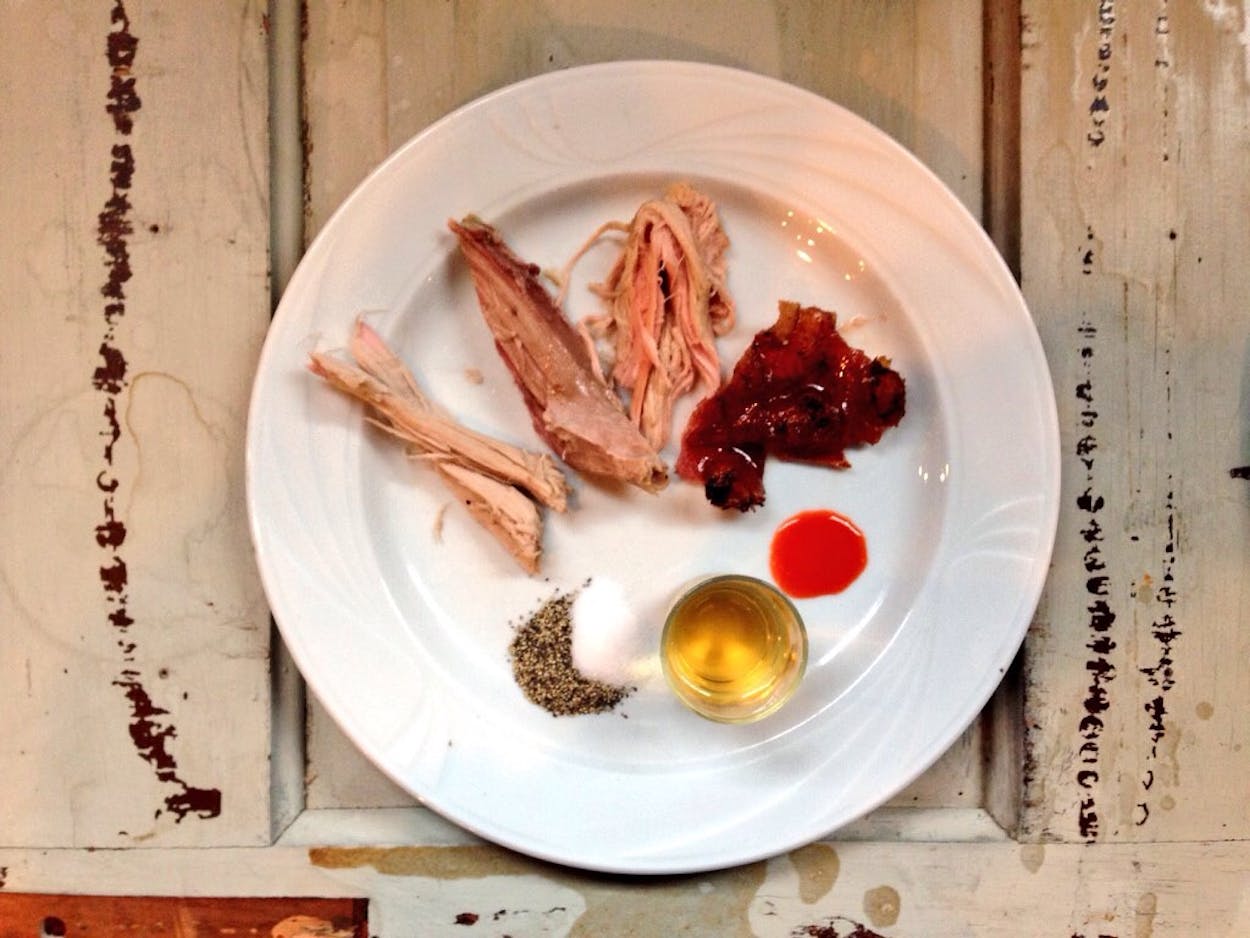Last week, seasoned pitmasters and aspiring barbecue cooks descended on tiny Murphysboro, Illinois, for the fourth annual Whole Hog Extravaganza and Brisket Bonanza. The students had paid good money to learn the secrets of the professionals, and the teachers weren’t shy about sharing their recipes for porchetta, whole hog, beef ribs, brisket, and even hot guts.
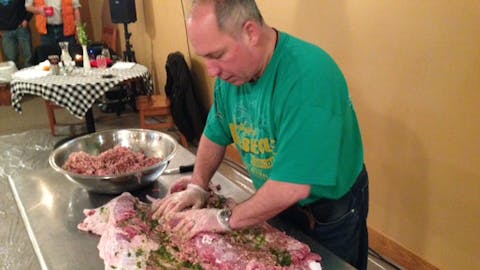
Gasp! Pitmasters sharing knowledge “proprietary” or “secret family recipes”? Say it ain’t so! Opening the vault on these guarded concoctions might seem as taboo as sharing wives, but that’s a myth perpetuated mostly by television producers. “I’d tell you, but I’d have to kill you,” has become a scripted cliché repeated into so many cameras that it’s lost its meaning. Of course, there are still plenty of barbecue joint owners out there that hold their recipes close to the vest. One in East Texas said his mix of five hardwoods was proprietary; Fargo’s in Bryan kept their pit a secret for years (for reasons relating to rival sports teams); and I got laughed at when I asked what went into the spicy beef links at Patillo’s in Beaumont. But I’ve found most Texas pitmasters to be open about their ingredients and the way they cook. When gathering the 25 recipes from pitmasters around the state for my book, The Prophets of Smoked Meat, I was turned down only once.
Maybe this Texas openness is owed to the relative simplicity of our barbecue where technique is given the credit, rather than the right mix of salt, pepper, and cayenne. But the collection of pitmasters that Amy Mills of 17th Street BBQ (and its offshoot OnCue Consulting) brought to Muphysboro—hailing from a bunch of places, including North Carolina, Nashville, Massachusetts, Chicago, and New York—were no different. When I inquired about any trepidation in sharing their recipes with potential competitors, Pat Martin of Martin’s Bar-B-Que Joint, in Nashville, was the most vocal. “I want to give.”
Martin is among a dying breed of whole hog cooks in Tennessee, and he’d like to do what he can to see the tradition flourish once again. “I think you have a moral obligation to help each other out,” he said. “When that happens we influence each other and become instrumental in each others lives.”
Samuel Jones of Skylight Inn in Ayden, North Carolina echoed those sentiments. More options for good barbecue in an area helps to bring in more visitors hungry for the stuff. Jones, who might as well be the Mark Twain of barbecue, said it better than I can: “Don’t worry about a half a shovelful if you can have a third of a dump truck.”
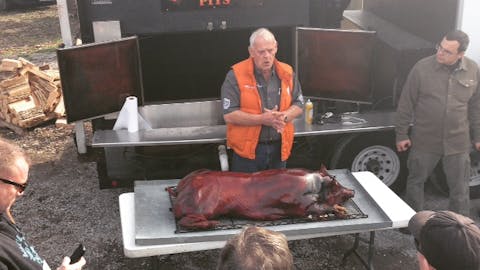
At the event, Martin shared his rub recipe along with some warnings about splitting a whole hog so it laid flat. “Don’t use a reciprocating saw unless you want a rooster tail of bone shards all over the hog.” Once it was prepared, Martin and his team loaded into his custom built, trailer-mounted cooker out back, then proceeded to answer detailed questions from anyone willing to ask.
The same process went on for Jones. The only seasoning he adds is salt on the skin side and enough water to make it stick. The most elaborate preparation was by the hometown boy and competition barbecue legend, Mike Mills. He demonstrated two hogs. The first hog was prepared like they do it in their restaurant 17th St. BBQ, and the other was worthy of a barbecue competition entry. He even gave tips on how to present it to the judges. Giving up those bits of competitive advantage by a competition cook exemplified the transparent nature of this group.
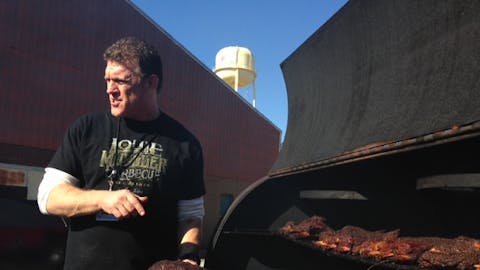
The Texans in attendance were just as generous. Wayne Mueller, of Louie Mueller Barbecue in Taylor, demonstrated his famous beef short ribs, but the much repeated rub recipe of nine parts black pepper to one part salt is already the worst kept secret in Texas barbecue. Even John Lewis of la Barbecue in Austin, who has been tight-lipped in the past about his spicy house-made sausage, provided a printed recipe of his spice blend and demonstrated every step of his sausage-making process. There were discussions about milk powder versus bull flour as a binder for beef sausages. It was beautiful to witness. I almost broke out in Kumbaya.
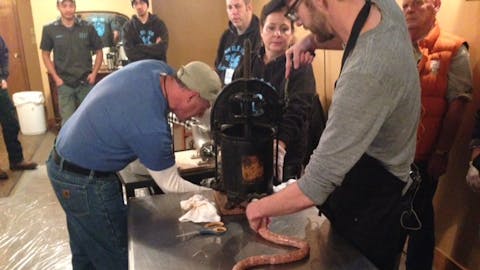
This isn’t John Lewis’s first foray into sharing barbecue secrets. He might not show you the exhaust inside his custom built smokers, but after a TMBBQ interview where he discussed his brisket technique, Lewis added more detail in the comments section:
Try 8 parts coarse ground pepper, 3 parts Lawry’s, 3 parts kosher salt, and one part granulated garlic. Rub it down with a half and half mixture of hot dog mustard and pickle juice first before sprinkling the rub on. If it’s not working for you, come down to la Barbecue and I’ll walk you through it.
One of the oldest names in Texas barbecue has been vocal in his stance on not sharing recipes, or at least accurate ones. Vencil Mares, of Taylor Cafe in Taylor, told the authors of Republic of Barbecue that he sometimes gives out recipes to curious customers, but “I never tell them the truth; they might try to take my business away.” At the whole hog event in Murphysboro, Samuel Jones downplayed the significance of copycats. He said he could easily serve Pat Martin’s sauce recipe, but “eating Pat Martin’s sauce is part of the experience of eating at Pat Martin’s restaurant.” It’ll never be as good in someone else’s place. Pat Martin reiterated that point: “You can’t keep secrets in barbecue. Just make the best dadgum food you can and let the chips fall where they may.”
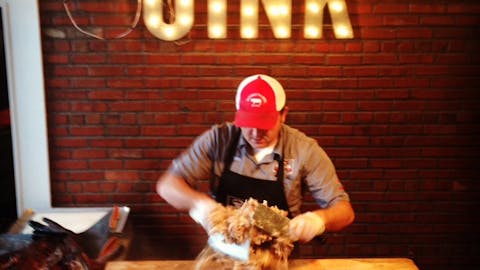
At the Q&A conclusion of the Whole Hog Extravaganza, I asked the organizer, Amy Mills, if any of the past or present pitmasters had pushed back on the requirement to share all their barbecue secrets to the class. “I’ve only had two people question it,” she told the crowd. And those two people were both in attendance. They must have gotten over it easily enough, and I have a theory as to why that is. Success in barbecue has much more to do with technique and the repetition that comes with experience than it than it does with a list of ingredients. The real secrets in that room weren’t in bottles and jars; they were the pitmasters themselves, and that doesn’t come in a recipe book. In the words of Samuel Jones “You know what the secret is? Getting your ass up before daylight to put the meat on the pit.”
A few years back Calvin Trillin wrote about his friend who had tried unsuccessfully to recreate the recipe for Chicken a la Grande from the famous Mosca’s restaurant outside New Orleans. His friend was a great cook, but couldn’t get it right. Trillin added this observation. “[W]hat I was once told by Charles Reynolds, a scholar of magic, about magic tricks has wider application: by reading enough books in enough libraries, you could learn how any trick is done, but that doesn’t mean you could do it.”
- More About:
- Wayne Mueller


